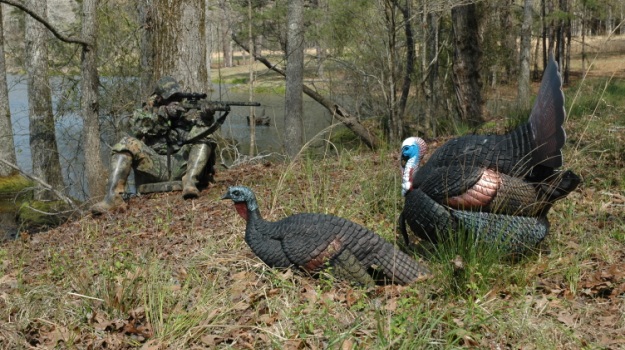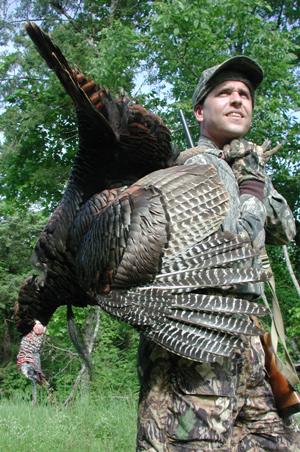
Editor’s Note: Matt Morrett represents Zink Wild Game Calls, Avian X decoys and the Plano Company. He has been a Mossy Oak Pro most of his life. After winning his first World Turkey Calling Championship when he was 16-years old, he has stacked-up turkey calling championships higher than he is tall. During turkey season, he probably sleeps in Mossy Oak camo, so he can jump out of the bed before first light and get out into the turkey woods. We've asked Matt this week to tell us how he deals with some of the worst turkey-hunting problems.
I've been in the outdoor industry for 30 years, and I've been hunting turkeys longer than that. I spent my childhood listening to and trying to sound like wild turkeys. When I was 16-years old, I won the World Turkey Calling Championship in the Friction Call Division. I continued competing in turkey calling and won five World Championships, the Grand National and the U.S. Open.
I use Avian X decoys, because they look like turkeys. Also, Avian X has several different positions and types of decoys that express the body language of a turkey. But let’s look at when decoys don’t work. I live in the northeastern part of the country where there’s a lot of hunting pressure. If a gobbler has seen a turkey decoy, comes in, spots a hunter, is shot at and missed by a hunter or possibly wounded, there's a really good chance that gobbler will run from a decoy.
I really like to use a strutting gobbler decoy. However, you don’t know which gobbler in the flock may come in to your calling. If a subordinate gobbler comes in, and he's already been beat up by a dominant gobbler, there's a very good chance that he's won’t come in and get his head bloodied again.
Many times, a turkey won’t come to a decoy, because the hunter has made a mistake in where he’s placed the decoy. If you hear a turkey gobbling straight out in front of you, and you set the decoy up straight out in front of you, if the turkey comes in, comes up over a hill and looks at that decoy, then if you look out of place, move or fidget or make any mistake at all, the turkey will spot you. He’ll leave that region. I’d never suggest that a turkey hunter put his decoy out right in front of where he's setup to take a turkey. Instead, place your decoy off to the left or to the right of where you're setup. Here’s another advantage of putting your decoy to the left or the right of where you're sitting, especially if you're using a gobbler decoy. If another hunter’s in the woods, sneaks up to the edge of that field and sees that gobbler decoy, he may take a shot at the gobbler decoy, thinking it’s the real thing. You sure don’t want to be in his sight picture.
 Many times when we hear a tom gobble close-by, we want to get our decoys out as fast as possible. So, we just hurry and move out in front of where we’re going to sit and setup our decoys. Once you hear a turkey gobble close to you that you haven’t heard before, most turkey hunters panic and want to put their decoys out. In the rush to setting-up, perhaps we put that decoy right in front of us. So, then when the turkey comes in, he's looking straight at us.
Many times when we hear a tom gobble close-by, we want to get our decoys out as fast as possible. So, we just hurry and move out in front of where we’re going to sit and setup our decoys. Once you hear a turkey gobble close to you that you haven’t heard before, most turkey hunters panic and want to put their decoys out. In the rush to setting-up, perhaps we put that decoy right in front of us. So, then when the turkey comes in, he's looking straight at us.
Using a turkey decoy is much like using duck decoys. You’ve got to use the correct kind of decoy at the right time of the year. In the early season, I prefer to use a strutting gobbler decoy because that’s the time of year that turkeys are setting-up their pecking order. They’ll be fighting to see which gobbler is the toughest and can round-up the most hens. When you put out a strutting-gobbler decoy, you're challenging every other gobbler in the woods. You're saying, “I'm the biggest, the strongest and the toughest, and I'm starting to breed hens. So, if you're going to breed my hens, you'll have to whip me first.”
In the early season, that strutting gobbler usually will bring in 2-year-old gobblers and older. Later in the season, switch your decoys. Primarily, use hen decoys, since all the gobblers are looking for receptive hens. If a gobbler sees a hen by herself, and no another gobbler nearby, he'll come in to breed her. If you don’t know when to use which decoy, I suggest that you use a hen and a jake decoy. The jake is a young-of-the-year gobbler, and any other gobbler that’s 2-years old and older should be able to whip him and run him off. The gobbler that wants to express his dominance will come to the decoys to run the jake off. Also, he’ll come to the decoy in hopes the hen is ready to breed.
Here’s another thing to consider. If you’ve had turkeys spooked from one decoy, change decoys, and use a different pose. If you’ve been using a hen that’s standing erect, and a gobbler has come in and seen you, the next time you hunt that same turkey, change up and use a feeding hen decoy or a breeding hen decoy. I really believe that decoys can put more gobblers in your game bag than hunting without decoys does. The number-one thing to remember is to never put a decoy straight in front of you. That’s the biggest mistake I see turkey hunters make when using decoys.
Day 3: Matt Morrett on How to Take a Field Turkey
Tomorrow: Matt Morrett Tells about Turkeys across Deep and Wide Creeks






























